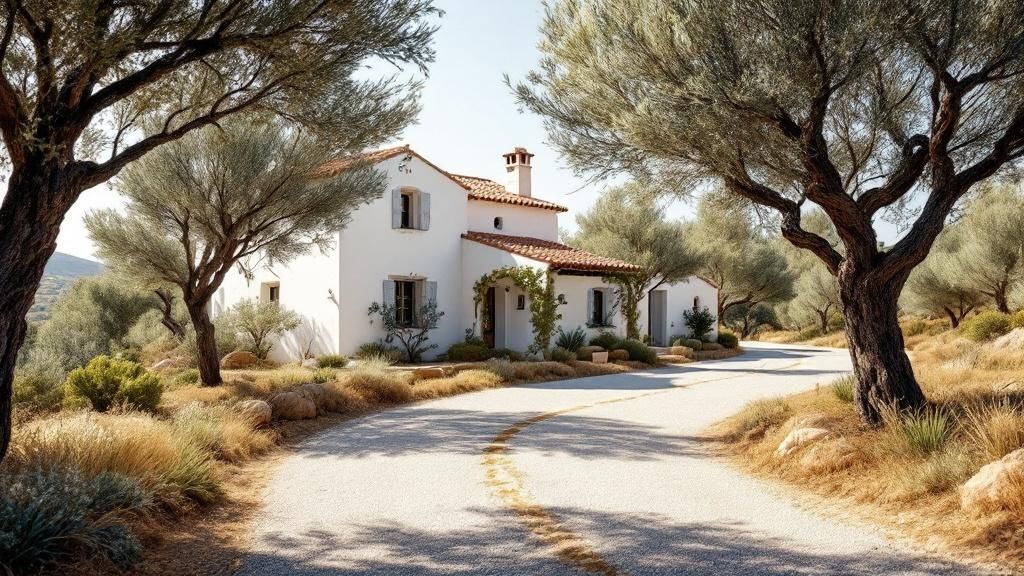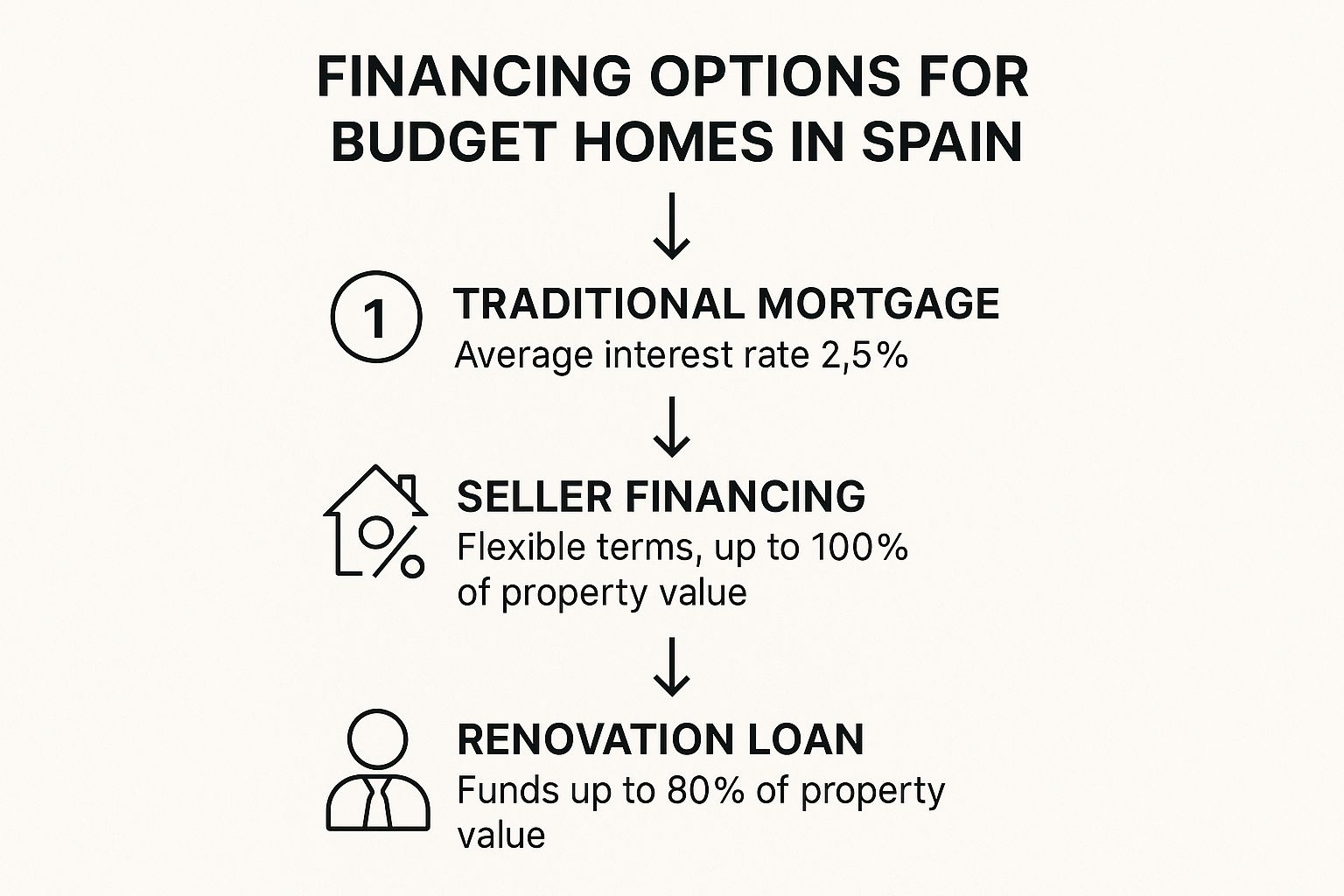Meta Description: Discover where to find cheap houses for sale in Spain. Our 2025 guide for international investors reveals the most affordable regions, navigating the purchase process, and avoiding common pitfalls.
Dreaming of acquiring a property in Spain, picturing sun-drenched villas for a nominal sum? While the mythical €1 houses are more folklore than reality, exceptional value can still be found by savvy international investors who know where to look. The key is to understand what constitutes 'cheap' in today's dynamic Spanish property market. The search for cheap houses for sale in Spain has evolved, and this guide will show you how to navigate it like a seasoned professional.
The Evolving Reality of a Spanish Property Bargain

For discerning investors and lifestyle buyers from the USA and Europe, the hunt for an affordable Spanish home is no longer about distressed sales on crowded coastlines. Instead, it's a strategic move towards acquiring high-potential properties in authentic, emerging regions. These opportunities are often located inland, where space, culture, and a more tranquil pace of life represent the new luxury.
Nick Marr, founder of Homesgofast.com and luxury real estate platform EuropeanProperty.com, has observed this shift among sophisticated buyers.
"The smart money is looking inland. Value is no longer just about proximity to a beach; it's about space, authenticity, and lifestyle potential. Regions that were once overlooked are now the epicentre of opportunity for international buyers seeking genuine value and a higher quality of life."
This strategic pivot is crucial. It requires looking beyond the saturated, high-priced markets of the Costa del Sol and embracing the rustic charm of regions where capital investment yields significantly more.
At a Glance: The Spanish Property Price Divide
To illustrate the significant disparity in property values, this table compares Spain's most expensive and most affordable autonomous communities. The data, sourced from a leading Spanish property portal Idealista as of late 2024, clearly indicates where investment potential lies.
| Region Type | Autonomous Community | Average Price per m² |
|---|---|---|
| Most Expensive | Balearic Islands | €4,312 |
| Most Expensive | Community of Madrid | €3,485 |
| Most Expensive | Basque Country | €3,043 |
| Most Affordable | Extremadura | €982 |
| Most Affordable | Castilla-La Mancha | €944 |
| Most Affordable | Castile and León | €1,180 |
This data highlights that an investor's budget can stretch three to four times further by shifting focus from prime tourist hotspots to Spain’s culturally rich interior.
Understanding Today's Market Dynamics
The concept of a "bargain" must be contextualised within the current market. Spain's real estate sector is robust, driven by strong domestic and foreign demand. According to the National Statistics Institute (INE), nationwide house prices have shown consistent growth, with the latest figures indicating a significant year-on-year increase.
Despite this appreciation, Spain remains highly competitive compared to other Western European markets. "Cheap" does not equate to derelict or poor quality. It signifies a well-priced asset, often available for under €150,000, offering a superior quality of life and considerable potential for capital growth. The most compelling deals are found where the majority are not yet looking.
Redefining Value for the Modern Investor
Today, the search for a cheap house for sale in Spain is less about the absolute lowest price and more about optimising overall value. This modern definition attracts a new cohort of global buyers and is predicated on several key pillars:
- Authentic Lifestyle: Access to genuine Spanish culture, gastronomy, and community, far from saturated tourist enclaves.
- Space and Tranquillity: The ability to acquire larger properties, potentially with land, that would be unattainable on the coast.
- Investment Potential: Entering markets at the beginning of their growth cycle, ensuring significant potential for value appreciation as they gain recognition.
- Lower Cost of Living: Beyond the property price, the day-to-day cost of living in these regions is substantially lower, enhancing the overall financial benefit. Explore our deep dive into Spain's cost of living trends.
By framing your search within this new paradigm, you can cut through market noise and identify truly exceptional opportunities. The affordable Spanish dream home is still very much attainable—for those willing to look beyond the obvious.
Where to Find Spain's Most Affordable Property
For those pursuing genuinely cheap houses for sale in Spain, the compass must point away from the densely populated costas. The real value and opportunity lie deep within the country's heartland. It is here, in the vast and beautiful interior, that one uncovers not just lower prices but a more authentic, tranquil Spanish lifestyle—an increasingly sought-after commodity for international buyers. Forget the premium price tags of Marbella and Ibiza; true value is found at the intersection of tradition, space, and affordability.
Let's explore the map to Spain's most affordable property markets.
Extremadura: The Rugged Frontier
Bordering Portugal, Extremadura is a region of dramatic landscapes, ancient Roman ruins, and stark, natural beauty. As one of Spain's least populated regions, it offers some of the lowest property prices in the country. Here, an investor's capital is significantly amplified, making it possible to secure a rustic village house or a sprawling rural estate—a finca—for a price that would be inconceivable on the coast.
For international buyers, Extremadura offers:
- Incredible Value: It is common to find properties for well under €1,000 per square metre.
- An Authentic Lifestyle: A region steeped in history, renowned for its Jamón Ibérico and unspoiled nature reserves.
- Space and Potential: Ideal for those seeking a renovation project, a smallholding, or a peaceful retreat from modern life.
The primary consideration is its relative remoteness. While cities like Cáceres and Mérida are culturally vibrant, access to an international airport requires a drive, a factor that must be weighed in any investment decision.
Castilla-La Mancha: The Heart of Spain
Immortalised in Cervantes' Don Quixote, Castilla-La Mancha is a vast plateau of historic towns and iconic windmills. As the region with some of the lowest average property prices in Spain, it is prime territory for bargain hunters. While UNESCO World Heritage sites like Toledo and Cuenca command higher prices, the smaller villages offer terraced houses and apartments at exceptionally low prices. The strategy here is to identify properties with character that require modernisation.
"Investing in a region like Castilla-La Mancha is a strategic move," advises Nick Marr. "You're not just buying a property; you're securing a piece of authentic Spanish heritage with massive potential for appreciation as infrastructure improves and more people discover its appeal."
This region is an excellent fit for buyers who prioritise cultural immersion over coastal convenience. Its central location, with Madrid often just a train ride away, provides a perfect blend of rural tranquillity and metropolitan access.
Castilla y León: A Land of Castles and History
North of Madrid lies Castilla y León, the largest autonomous community in Spain. This is a region of majestic cathedrals, ancient universities, and sweeping plains. While major cities like Salamanca and Burgos have higher price points, the surrounding rural areas are replete with exceptional deals. Traditional stone houses in quiet villages await restoration. The region's cooler climate and verdant landscapes often appeal to buyers from Northern Europe, the USA, and South America looking for a different Spanish experience.
Key considerations include:
- Renovation Scope: Many of the cheapest properties are older and will require investment to update plumbing, electrics, and insulation.
- Local Amenities: In smaller villages, assess the proximity to essential services such as healthcare, shops, and transport links.
- Connectivity: While the road network is excellent, international travel may necessitate a drive to a regional airport or Madrid.
Galicia: The Green Corner of Spain
Often likened to Ireland for its lush landscapes and rugged coastline, Galicia offers a unique proposition. Located in Spain's northwest corner, it boasts a distinct Celtic culture, world-class seafood, and property prices far removed from the Mediterranean. Here, one can find everything from a coastal apartment to a rural stone farmhouse (casa de piedra) awaiting restoration. The climate is milder and wetter than in the south, a significant advantage for those escaping extreme summer heat. The famed Camino de Santiago pilgrimage route adds to its cultural allure and presents opportunities for small-scale tourism ventures.
By looking inland and to emerging hotspots, away from fiercely competitive coastal markets, investors can discover the incredible value Spain truly offers. These regions provide not just an affordable entry point, but a richer, more authentic Spanish living experience.
Understanding the Market for Affordable Spanish Homes
The significant price variations across Spain’s property market are not arbitrary. They are driven by powerful economic and demographic forces. Understanding these is key to acquiring a valuable asset, not just a cheap liability. At the core of today's market is a fundamental imbalance: supply and demand.
Spain faces a significant housing shortage that is exerting upward pressure on prices. The Bank of Spain has identified a national shortfall, meaning that even in the hunt for a bargain, competition from both local and international buyers is intensifying, pushing them into previously overlooked regions. This nationwide pressure acts as a discovery mechanism, directing astute buyers towards the country's interior and less-developed coastlines where real value still exists.
What Does a 'Cheap' Spanish Property Actually Look Like?
When discussing affordable homes in Spain, it's essential to manage expectations. The opportunities are rarely in modern, turnkey villas with pools. Instead, they fall into distinct categories:
- Homes Requiring Renovation: Often older properties rich in character, located in village centres or historic quarters. They offer immense potential to add value but require a realistic renovation budget.
- Rural Fincas: Traditional farmhouses or country estates, frequently with substantial land, offering space, privacy, and an authentic lifestyle. They may require significant work on infrastructure like plumbing, electricity, and internet connectivity.
- Apartments in Non-Touristy Towns: Moving away from primary tourist areas reveals well-maintained apartments in authentic Spanish towns at a fraction of coastal prices, offering genuine cultural immersion.
"The secret is to see these properties not just for what they are, but for what they could become," Nick Marr notes. "A well-chosen renovation project in an area that’s on the up can deliver serious capital growth as the market catches up."
This mindset transforms a simple price search into a sophisticated analysis of long-term value and desired lifestyle.
A Balanced View on Investment Potential
While the allure of a low purchase price is strong, a prudent investor always balances potential for growth against inherent risks. The prospect for capital appreciation in Spain’s affordable inland regions is tangible. As prime coastal hotspots become increasingly saturated and expensive, demand naturally spills over into adjacent areas, driving up values. Our detailed guide explores the trends that ensure Spain remains an overseas property hotspot.
However, a clear-eyed assessment of the trade-offs is essential.
Risks Versus Rewards
| Factor | Potential Reward | Potential Risk |
|---|---|---|
| Rental Demand | Opportunity for unique holiday lets (e.g., rural tourism) appealing to a niche market seeking authenticity. | Rental demand is often lower and more seasonal than in prime coastal locations, potentially affecting income streams. |
| Liquidity | A lower entry price point creates potential for a higher percentage return on investment upon resale. | The market moves more slowly, which may mean a longer timeframe to sell the property compared to high-demand areas. |
| Infrastructure | Enjoyment of authentic, peaceful living away from overcrowded tourist zones. | Infrastructure can be less developed, impacting accessibility, local amenities, and high-speed internet availability. |
Ultimately, securing a true bargain is about more than the sticker price. It requires a strategic market analysis, a willingness to explore where others are not, and a clear assessment of one's investment and lifestyle goals. Armed with this knowledge, you are positioned to identify the opportunities that others miss.
Navigating the Purchase Process Like a Pro

Acquiring property in Spain is a well-defined process that, when understood, is both straightforward and secure. For anyone pursuing cheap houses for sale in Spain, mastering these steps is what transforms aspiration into reality without unforeseen complications. Success is less about navigating legal complexity and more about engaging the right professional team.
The initial, mandatory step for any non-resident is obtaining a NIE number (Número de Identificación de Extranjero). This is your unique tax identification in Spain, and it is a prerequisite for buying property, opening a bank account, or paying taxes. It is your foundational key to the Spanish property market.
Assembling Your Professional Team
With your NIE secured, the next step is to build your local professional team. While several roles are involved, one is absolutely non-negotiable for a secure transaction.
- The Gestor: An administrative specialist who assists with bureaucracy, such as connecting utilities and managing tax payments. They are useful but are not a substitute for a lawyer.
- The Notario (Notary): A public official who witnesses the signing of the final deed (escritura). Their role is to verify identities and ensure the legality of the sale. The notario works for the state, not for the buyer or seller.
- The Abogado (Property Lawyer): This is your most critical hire. An independent property lawyer acts solely in your interest. Their responsibility is to conduct all legal checks, protect your investment, and ensure the property is free of debts or legal encumbrances.
For any serious investor considering a cheap house for sale in Spain, particularly an older rural property, engaging an independent abogado is the single most important investment you can make. They are your defence against hidden issues that can turn a bargain into a financial liability.
Budgeting for Additional Costs
The advertised price is not the final figure. A critical part of financial planning is budgeting for ancillary taxes and fees, which typically add 10-15% to the purchase price.
These costs invariably include:
- Property Transfer Tax (ITP): The most significant tax, varying by region but generally ranging from 6% to 10% of the sale price.
- Notary Fees: For the preparation and witnessing of the final deed.
- Land Registry Fees: The cost to officially register the property in your name.
- Legal Fees: Your abogado's fees, typically around 1-1.5% of the property’s value.
Accounting for these costs from the outset ensures a realistic budget and prevents last-minute financial stress.
The Importance of Due Diligence
Your lawyer's most crucial function is performing exhaustive due diligence. This is the safety net that protects your entire investment.
"A cheap property is only a good deal if it's legally sound. The due diligence process is where you separate genuine opportunities from potential disasters. Verifying the property deed and checking for hidden debts are non-negotiable steps."
Key checks include examining the property's title deed (escritura) to confirm the seller is the legal owner. They will also obtain the Land Registry record (Nota Simple) to check for outstanding mortgages, debts, or legal claims. For rural fincas, they must also verify that the property was built legally and possesses all necessary planning permissions—a critical issue to avoid inheriting. By following these steps and relying on a professional team, you can confidently navigate the purchase of your affordable dream home in Spain.
Common Pitfalls When Buying Cheap Property in Spain
A low price tag can be alluring, but it can also conceal underlying issues that transform a dream bargain into a financial nightmare. When searching for cheap houses for sale in Spain, a healthy dose of professional scepticism is your greatest asset. Many affordable properties, especially charming older rural homes, come with a complex history that requires thorough investigation to avoid costly future surprises. It is about looking beyond the purchase price to understand the true cost of ownership.
The Reality of Renovation Costs
One of the most significant traps is underestimating renovation costs. A beautiful stone finca may appear idyllic in photographs, but modernising its plumbing, wiring, and insulation is a substantial and often expensive undertaking. Before making an offer, it is imperative to obtain detailed, written quotes from reputable local builders. This is not merely a budgeting exercise; it is a critical component of your due diligence. A professional structural survey will uncover issues not visible to the naked eye, providing a clear and realistic view of the required investment. For a deeper look, consult our guide on the common pitfalls of buying property in Spain.
The Spectre of Illegal Builds
Another major risk, particularly in rural areas, is the issue of illegal construction (ilegal). A property may have been built on land not zoned for residential use, or a previous owner may have added an extension or swimming pool without the required permits. This is more than a mere paperwork issue. An illegal build can be impossible to sell, difficult to mortgage, and in a worst-case scenario, the local town hall (ayuntamiento) could issue a demolition order. This is where your lawyer proves their worth, meticulously verifying every detail of the property's legal status by cross-referencing land registry and local planning office records. This step is non-negotiable.
Understanding Local Affordability
Finally, it is essential to analyse the local economic context. A cheap house in an area with low wages and limited employment opportunities may not be the sound investment it appears. The concept of 'affordability effort'—the percentage of a local family's income required to service a mortgage—is a key indicator. This metric is a significant challenge across Spain. The national average 'annual theoretical effort' sits at a high level, but in prime areas, it can be substantially higher, far exceeding the recommended threshold. This data explains why a property might be cheap: the local economy may not sustain higher prices. This can significantly impact your property's potential for long-term capital appreciation.
Your Strategy for Securing a Spanish Bargain

Securing a genuinely affordable home in Spain is not a matter of luck; it is the result of a smart, decisive strategy. The best deals are not found in mainstream tourist areas but are discovered by those who conduct thorough research, explore further inland, and assemble a trusted professional team.
Success begins with a rigorous assessment of your finances. You must establish your total budget, incorporating the additional 10-15% for taxes and fees. Finalising this figure from the outset is the single most important step to prevent future complications.
Building Your Foundation for Success
Your next action should be to engage a reputable, independent lawyer (abogado) from the very beginning. This professional is your most critical ally, particularly when targeting cheap houses for sale in Spain, as older properties often have complex legal histories. Their role is to protect your interests and ensure a clean title.
Simultaneously, you must be ruthlessly realistic about a property's condition. Many of the best-value opportunities are fixer-uppers.
"A bargain property's true value is often unlocked through thoughtful renovation. Being realistic about potential repair costs and timelines from the outset is what separates a savvy investor from a frustrated buyer."
This necessitates commissioning professional surveys and obtaining builder quotes before you are financially or emotionally committed. There are no shortcuts.
Your Actionable Checklist for Buying a Spanish Bargain
To simplify the process, this checklist distils the essential steps for a successful acquisition.
- Define Your Total Budget: Calculate your absolute maximum expenditure, including the crucial 10-15% for taxes (ITP), notary fees, and legal costs.
- Look Beyond the Obvious: Focus on high-potential inland regions like Extremadura or Castilla-La Mancha, where value for money is exceptional.
- Engage an Independent Lawyer Early: Your abogado should be one of your first engagements, ready to vet properties as you identify them.
- Be Realistic About Renovations: Assume any older, cheaper property will require work. Integrate these costs into your total budget from the start.
- Conduct Thorough Due Diligence: Never skip a property survey. Your lawyer must verify the Nota Simple and escritura to ensure there are no hidden debts or illegal structures.
Your affordable Spanish dream home is entirely achievable. With a robust strategy, you can navigate the market with confidence. The journey begins by exploring the incredible opportunities available now on HomesGoFast.com.
Your Questions Answered
When beginning your research into the market for cheap houses for sale in Spain, several questions inevitably arise. Here are direct answers to the most common queries from international buyers, designed to provide clarity and confidence.
Can I Really Buy a House in Spain for 1 Euro?
While headlines about Spanish villages selling homes for €1 are captivating, this is not a realistic pathway for the vast majority of international buyers. These schemes are exceedingly rare and are accompanied by stringent, legally binding conditions, such as committing to costly renovations on a tight schedule or mandatory residency requirements. A more practical entry point for a habitable home in an affordable region like Extremadura or Castilla-La Mancha is between €40,000 and €80,000. This budget provides access to a wide range of properties ready for occupation, without the high-stakes pressure of the €1 initiatives.
What Are the Hidden Costs of Buying a Cheap Spanish House?
This is a critical question. As a rule of thumb, budget an additional 10-15% on top of the property's sale price to cover all taxes and fees. The largest component is the Property Transfer Tax (ITP), which varies by region but typically falls between 6-10%.
Other unavoidable costs include:
- Notary Fees: For officially witnessing and signing the property deed.
- Land Registry Fees: To officially register the property in your name.
- Legal Fees (Abogado): Your lawyer will typically charge 1-1.5% of the purchase price.
With older, cheaper properties, the most significant potential "hidden" cost is the renovation itself. Before committing, always commission a professional survey (informe técnico). It is the only way to obtain a realistic estimate of repair costs and avoid unforeseen financial burdens.
Can Foreigners Get a Mortgage for a Cheap Property in Spain?
Yes, absolutely. Spanish banks are accustomed to lending to non-resident buyers, but the terms are typically stricter than for residents. Expect a lower Loan-to-Value (LTV) ratio, usually around 60-70% of the property’s valuation or purchase price (whichever is lower). It's also worth noting that some banks may have minimum loan amounts and might be hesitant to lend on very cheap properties (e.g., under €50,000), especially older, rural homes requiring extensive work. This is why securing mortgage pre-approval is a crucial first step. It not only clarifies what you can afford but also positions you as a serious, credible buyer to sellers and agents.
At HomesGoFast.com, we specialise in connecting international buyers with affordable properties in Spain's most promising and beautiful regions. Ready to find your place in the sun?
👉 Start exploring cheap houses for sale in Spain
About Homesgofast.com
HomesGoFast.com is a leading international property website, established in 2002, helping homeowners, real estate agents, and developers reach overseas buyers. Featuring thousands of listings from over 50 countries, the platform connects global property seekers with homes, apartments, villas, and investment opportunities worldwide.
Looking for expert mortgage guidance? Get international property mortgage advice here:
👉 https://homesgofast.com/mortgages-overseas/
Explore more overseas homes for sale at our global partner site:
👉 https://homesgofast.com/overseas-property/
Looking to sell real estate to foreign buyers
https://homesgofast.com/sell-overseas-property/




